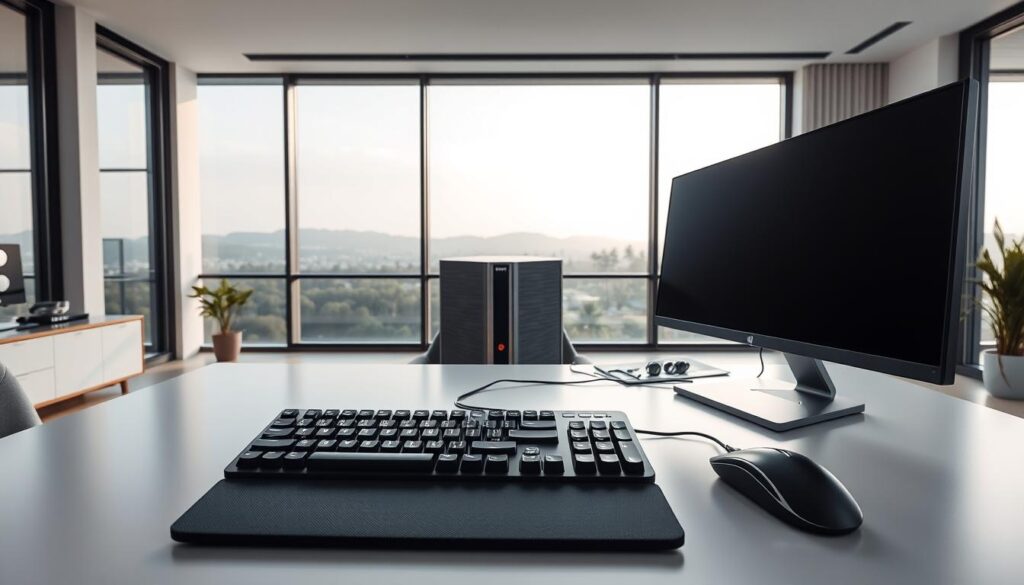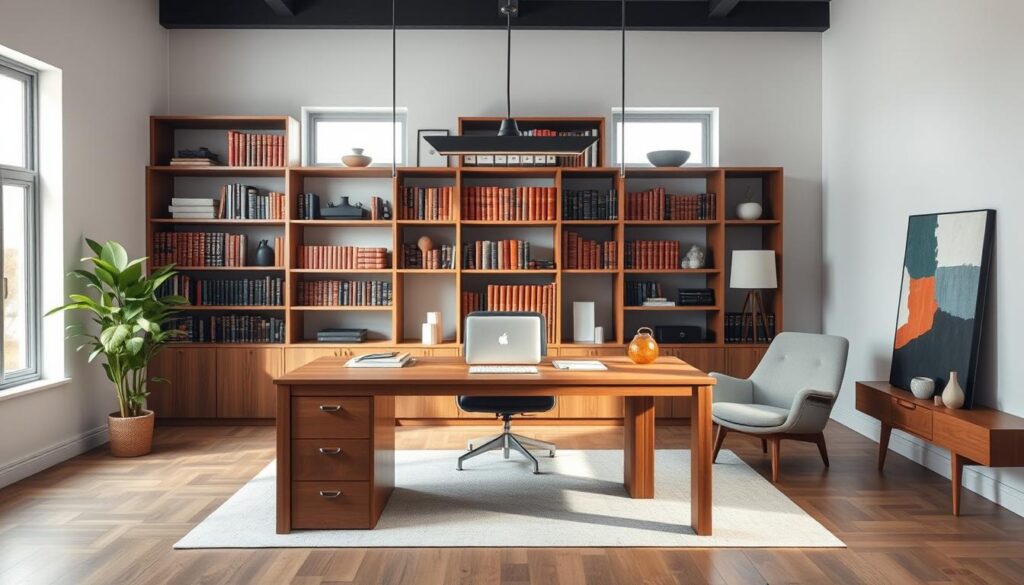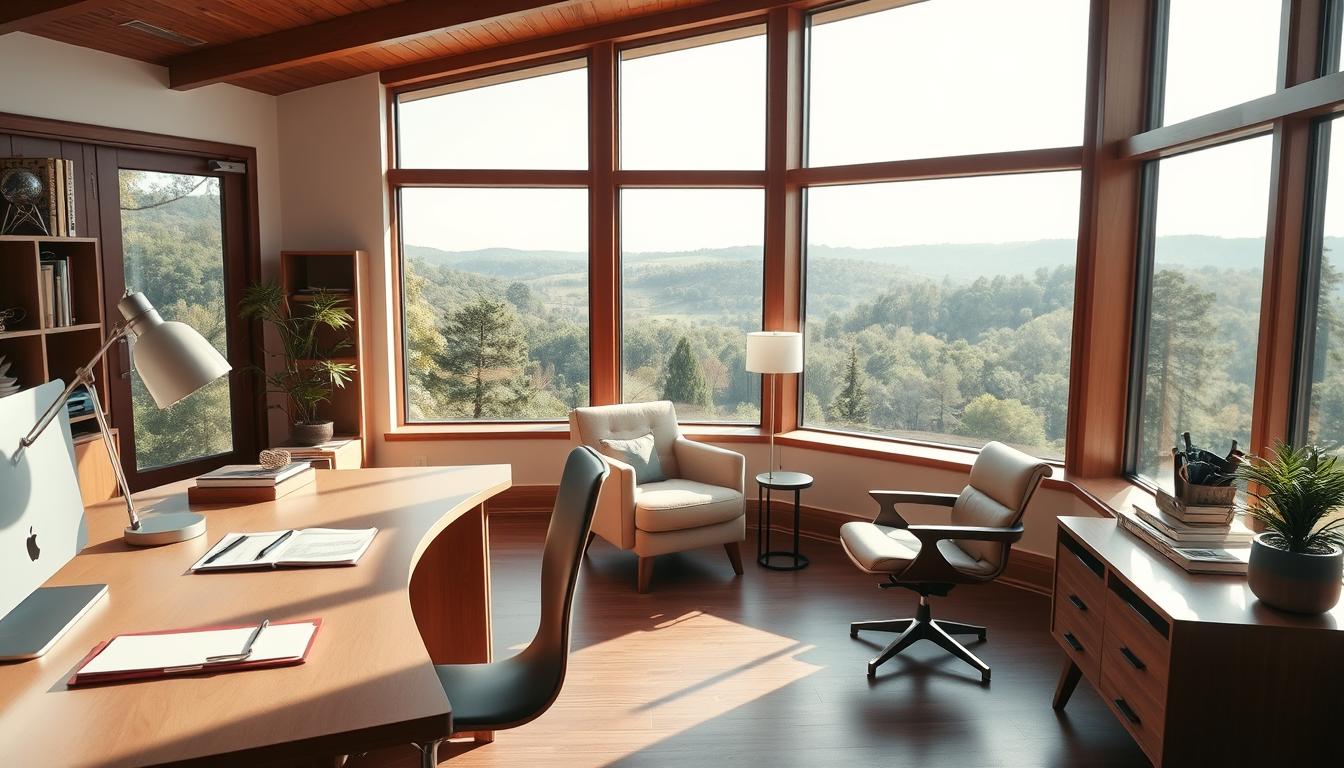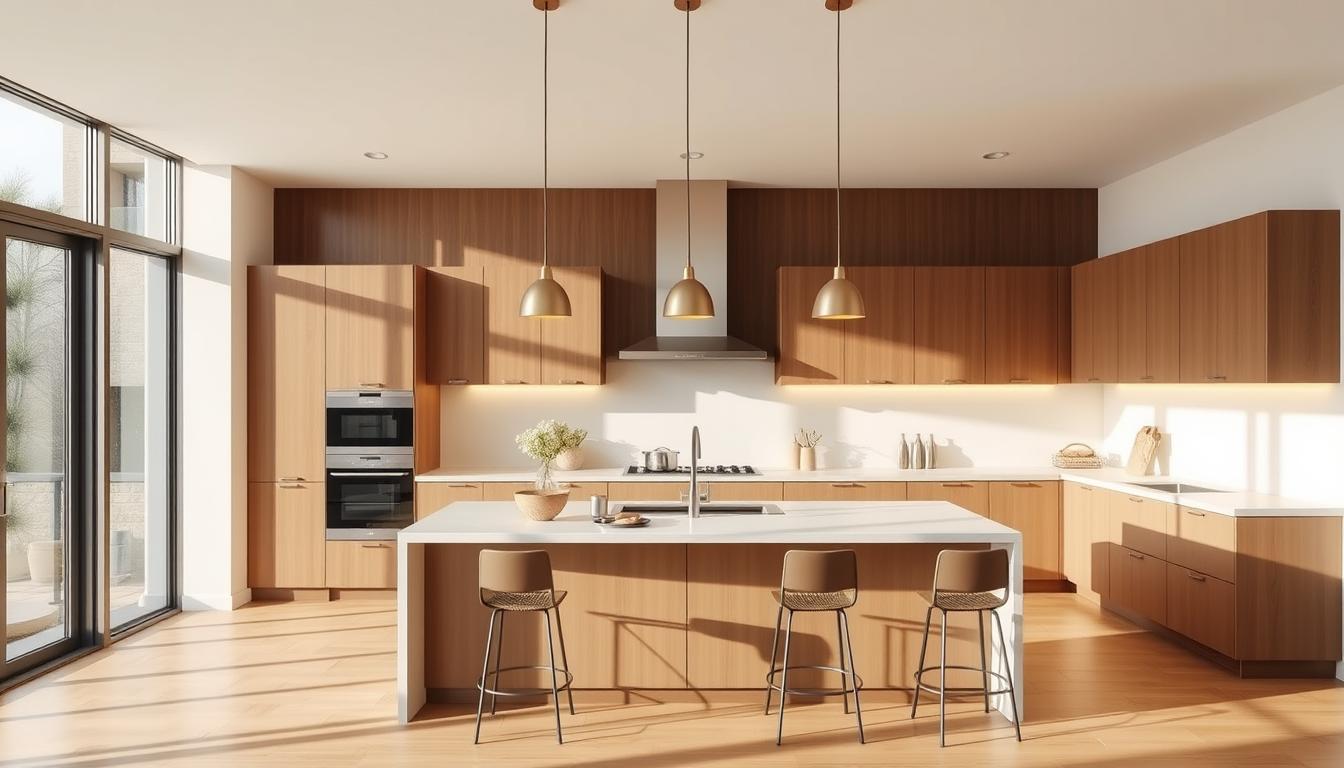Did you know a well-designed workspace can increase productivity by up to 20%? With more people working from home, having an efficient interior home office is key. It helps you stay focused and creative.
We’ll show you how to turn any space into a great workspace. We’ll cover everything from figuring out what you need to picking the best furniture and tech. Our guide has it all.
Key Takeaways
- Assess your available space to maximize efficiency.
- Choose furniture that promotes comfort and productivity.
- Incorporate technology to streamline your work.
- Consider the aesthetics of your workspace to boost creativity.
- Implement strategies to minimize distractions.
Understanding the Importance of a Dedicated Workspace
Creating a dedicated home office is crucial for separating work from personal life. It boosts your quality of life. A dedicated space lets you design an area just for work, helping you focus better and work more efficiently.
Benefits of Having a Home Office
Home offices offer many advantages. They give you more flexibility, save time on commuting, and let you tailor your space to your needs. A well-designed office also boosts your professional image and helps balance work and personal life.
- Increased Productivity: A dedicated space keeps you focused and away from distractions.
- Improved Work-Life Balance: It helps separate work from personal life, reducing stress and improving well-being.
- Customization: You can make your space comfortable and efficient, fitting your needs perfectly.
How It Impacts Productivity
A dedicated workspace greatly boosts productivity. It provides a work-friendly environment. This means having the right furniture, fewer distractions, and a layout that works for you.
Research shows a well-organized workspace can increase productivity by up to 20%. This is thanks to:
| Aspect | Impact on Productivity |
|---|---|
| Ergonomic Furniture | Reduces discomfort and fatigue, allowing for longer work periods. |
| Minimized Distractions | Helps maintain focus on tasks. |
| Optimized Layout | Streamlines workflow, reducing time spent on tasks. |
Designing for Comfort and Focus
Designing a home office for comfort and focus requires careful thought. It involves using the right lighting, comfortable seating, and keeping things tidy.
- Lighting: Make sure there’s enough natural and artificial light to avoid eye strain.
- Ergonomics: Choose furniture that supports good posture and reduces discomfort.
- Organization: Use good storage to keep your space organized and free of clutter.
Assessing Your Space for an Interior Home Office
To design a great home office, start by checking your space. Look at your home’s layout, room sizes, and how to use the space well.
Evaluating Available Rooms
Walk through your home to find rooms for a home office. Think about natural light, noise, and location. A room with lots of natural light is perfect for boosting mood and productivity.
Also, measure the room to see if it fits your office needs. Use resources like crafting a stylish and functional home for furniture ideas.
Maximizing Small Spaces
For small spaces, use multi-functional furniture to save room. A desk with storage keeps supplies organized and out of sight.
Use vertical space with shelves or wall storage to clear the floor. This makes the room feel bigger. Think about the room’s flow and comfort when arranging your home office furniture layout.
Open Concept vs. Separate Room
Choose between an open-concept or separate room office based on your style and needs. An open-concept office is good for those who like to work and live together. But, it can be distracting if not managed.
A separate room offers a distraction-free space for focus. Think about your needs and home layout when deciding.
By carefully evaluating your space and needs, you can make a home office that’s both useful and cozy. Whether it’s small or a dedicated room, design it to support your work and well-being.
Choosing the Right Office Furniture
The right office furniture can greatly improve your workspace. It should be both functional and look good. Think about the work you’ll do and what furniture will help you stay productive and comfortable.
Essential Furniture Pieces
There are key pieces to consider for your home office. You’ll need a comfy and ergonomic chair, a big desk, and enough storage. A good chair helps prevent back pain and keeps your posture right. A big desk gives you room for your computer, papers, and supplies.
Here’s a list of the must-have furniture for your home office:
| Furniture Piece | Description | Benefits |
|---|---|---|
| Ergonomic Chair | A chair designed to support your back and promote good posture | Reduces back pain, improves posture |
| Spacious Desk | A desk that provides enough space for your computer, papers, and office supplies | Increases productivity, reduces clutter |
| Storage Solutions | Bookshelves, file cabinets, or drawers that help keep your office organized | Enhances organization, reduces stress |
Ergonomics and Comfort
Ergonomics is key for a comfy and healthy workspace. An ergonomic setup prevents injuries and reduces eye strain and back pain. Use an ergonomic chair, a standing desk, or a monitor riser for a comfortable space.
Style and Aesthetics
Functionality is important, but style matters too. Pick furniture that shows your personal taste and fits your home’s design. Add creative office decor ideas to make your space inspiring and fun.
By mixing functionality, ergonomics, and style, you can have a home office that’s both productive and nice to look at. Whether your space is small or big, the right furniture makes a big difference in your work life.
Selecting an Appropriate Color Scheme
A good color scheme can make your home office feel better. It can help you focus and be more creative. The colors you pick can change how you feel and work.
Impact of Color on Productivity
Colors affect people differently. Blue can make you calm and focused. Green helps reduce eye strain and keeps things balanced. Yellow and orange boost creativity and energy.
Think about your work and the mood you want. Warm colors are great for creative tasks. Cool colors are better for tasks that need a lot of focus.
Popular Color Trends for Home Offices
Modern home offices often use a mix of colors. Some trends include:
- Monochromatic schemes for a unified look
- Neutral backgrounds with bold accent walls
- Nature-inspired colors for calmness
Here are some popular color combinations:
| Color Scheme | Description | Ideal For |
|---|---|---|
| Blue and White | Calming and clean | Tasks requiring focus |
| Green and Wood Tones | Nature-inspired and balancing | Reducing eye strain |
| Yellow and Gray | Stimulating and modern | Creative tasks |
Creating a Cohesive Look
To get a unified look, think about what you want your office to feel like. Look at workspace interior ideas that match your colors. Make sure your colors go well with your furniture and decor.
Choosing colors wisely can make your office look good and help you work better.
Lighting Considerations for Home Offices
Lighting is key in a home office for both work and comfort. The right light can make a big difference in how we feel and work.
Natural Light vs. Artificial Light
Natural light is great for home offices as it improves mood and productivity. But, it’s not always enough, so we need artificial light too.
Maximizing Natural Light: Place your desk near a window for natural light. Use sheer curtains to soften the light and cut down on glare.
Artificial Lighting: If natural light is lacking, use artificial light that feels like daylight. LED bulbs are a smart choice because they save energy and come in different colors.
Task Lighting Best Practices
Task lighting is essential for tasks like reading or computer work. Here are some tips:
- Use adjustable desk lamps to focus light where you need it.
- Look for lamps with a high Color Rendering Index (CRI) for true colors.
- Avoid bright lights that can hurt your eyes.
Dimmers and Controls for Flexibility
Dimmers and controls add flexibility to your lighting. They let you change light levels for different times and tasks.
“Being able to adjust light levels can really affect our comfort and work in the home office.”
With dimmers, you can make your workspace more flexible. It adapts to your needs all day long.
Technology Needs for Efficiency
In today’s digital world, the right technology is key for a productive home office. As we work from home, technology boosts our efficiency and makes our workflow smoother.
Essential Tech Tools for Productivity
To boost efficiency, we must add the right tech tools to our home office. Some must-haves include:
- Reliable computers or laptops
- High-speed internet connectivity
- Printers and scanners
- Noise-cancelling headphones
- External monitors for multitasking

Cable Management Tips
A messy workspace can slow us down. Keeping cables organized is key for a tidy home office. Here’s how:
- Use cable ties or zip ties to keep cables organized
- Implement a cable management box to hide excess cables
- Label cables for easy identification
- Route cables behind furniture or through cable clips
Software for Organization
The right software can greatly enhance our organization skills. Some top picks include:
| Software Type | Functionality | Examples |
|---|---|---|
| Project Management | Manage tasks and projects | Trello, Asana |
| Time Tracking | Track time spent on tasks | Harvest, Toggl |
| Note-taking | Organize notes and ideas | Evernote, OneNote |
By using these tech solutions, we can make our home office more efficient and productive.
Organizing Your Workflow in the Home Office
A well-organized workflow is key to a successful home office. It boosts your productivity and makes work better in your interior home office.
Workflow Layout and Design
Designing an efficient workflow layout is crucial for office space organization. Place your furniture and equipment to make work flow smoothly. Use the “work triangle” concept to place your desk, filing cabinet, and chair for less movement and more efficiency.
Utilizing Storage Solutions
Good storage keeps your home office tidy and organized. Choose furniture that serves more than one purpose, like a desk with storage or a filing cabinet that’s also a shelf. Labeling your storage helps you find what you need fast, making your workflow smoother.
Decluttering Regularly
Regular decluttering keeps your home office organized and productive. Set aside time to clean up, get rid of papers you don’t need, and dust your gear. A clean workspace reduces stress and boosts focus and productivity.
By following these tips, you can make your home office more organized. This improves your efficiency and productivity. A well-organized workspace is essential for a successful and stress-free work environment.
Personalizing Your Workspace
Creating a home office that looks good and works well needs careful thought. Your space should show who you are and help you stay focused. Adding personal touches and inspiring decor can make your area more creative and motivating.
Adding Personal Touches
Adding personal items to your home office makes it feel welcoming and inspiring. Think about showing off family photos, artwork, or things you love. Personal mementos or objects that make you happy can also boost your motivation.
Some ideas for personal touches include:
- Displaying personal collections or memorabilia
- Incorporating sentimental objects or heirlooms
- Adding plants or flowers to brighten up the space
Inspirational Décor Ideas
Inspirational decor is key to a motivating workspace. Think about adding things that inspire you, like vision boards, motivational quotes, or art that speaks to your dreams.

- Creating a vision board to visualize your goals
- Displaying motivational quotes or affirmations
- Incorporating artwork or prints that inspire creativity
Balancing Professionalism and Personality
It’s important to keep your workspace both personal and professional. Find a balance by mixing your personal style with more formal elements. A sleek desk or a standout piece of furniture can help.
Tips for balancing professionalism and personality include:
- Mixing personal items with professional décor
- Using a neutral color palette as a backdrop for personal touches
- Incorporating statement pieces that reflect your personality
Incorporating Plants and Nature
Mixing your workspace with nature can make it more productive and peaceful. Adding elements of nature to your home office boosts both looks and function.
Benefits of Greenery
Plants in your office improve air quality, lower stress, and lift your mood. They also cut down on distractions and help you focus better, leading to more work done.
Here are some key benefits of having plants around:
- Improved Air Quality: Plants clean the air by removing harmful substances.
- Enhanced Creativity: Nature sparks creativity and brings new ideas.
- Reduced Stress: Plants calm you down and reduce anxiety.
Best Indoor Plants for Workspaces
Not all plants do well indoors, but some are perfect for offices. Here are top picks for indoor plants:
- Snake Plant: It purifies the air and grows well in little light.
- Spider Plant: Simple to care for and cleans the air.
- Peace Lily: Looks elegant and removes toxins from the air.
For more workspace interior ideas, check out our other resources. They offer inspiration for a productive and lovely home office.
Creative Ways to Include Nature
There are many ways to bring nature into your office design. Use natural materials like wood or bamboo for furniture. This adds warmth and texture.
Other ideas include:
- Natural Light: Place your workspace near a window to use natural light.
- Water Features: A small fountain adds a calming touch.
- Natural Art: Hang art or prints with natural themes.
By adding plants and natural elements thoughtfully, you can make a home office that’s productive and reflects your style and love for nature.
Maintaining Work-Life Balance
Having a workspace at home means you need to separate work from personal time. This is key to lowering stress and boosting well-being.
Setting Boundaries in Your Home Office
To keep a good work-life balance, setting boundaries in your home office is crucial. Here’s how:
- Stick to specific work hours
- Use a dedicated workspace only for work
- Have a routine to mark the start and end of your workday
These steps help keep work out of your personal time. This way, you can rest and stay productive.
Tips for Staying Focused
Working from home can make it hard to stay focused. Here are some tips to help:
- Turn off phone notifications and close tabs you don’t need
- Use tools to stay organized and manage your time well
- Take breaks to keep your mind fresh and avoid burnout
Following these tips can improve your focus and productivity at home.
Creating a Closing Ritual
A closing ritual helps mark the end of your workday. It can be something simple like:
- Closing your laptop and putting away work materials
- Doing something relaxing, like reading or meditation
- Going for a short walk to clear your mind
A closing ritual helps you switch from work mode to personal time. This improves your work-life balance.
In summary, keeping a work-life balance at home needs discipline and good habits. By setting boundaries, staying focused, and having a closing ritual, you can enjoy your home office without losing your personal life.
Future-Proofing Your Home Office Design
When designing our home offices, thinking about the future is key. A good home office should grow with us, adapting to new needs and styles. By using the latest trends, we can make a space that looks great and works well for years.
Current Trends and Adaptability
Today’s home office designs focus on being flexible and green. To make our office future-ready, we should pick items that can change or grow with us. Think about using modular furniture or tech that can be updated easily.
Investing in Timeless Quality
Choosing quality over quantity is vital for a lasting home office. Opting for durable, classic pieces ensures our space stays both useful and beautiful. This approach also helps reduce waste, keeping our office a productive and inspiring place.



